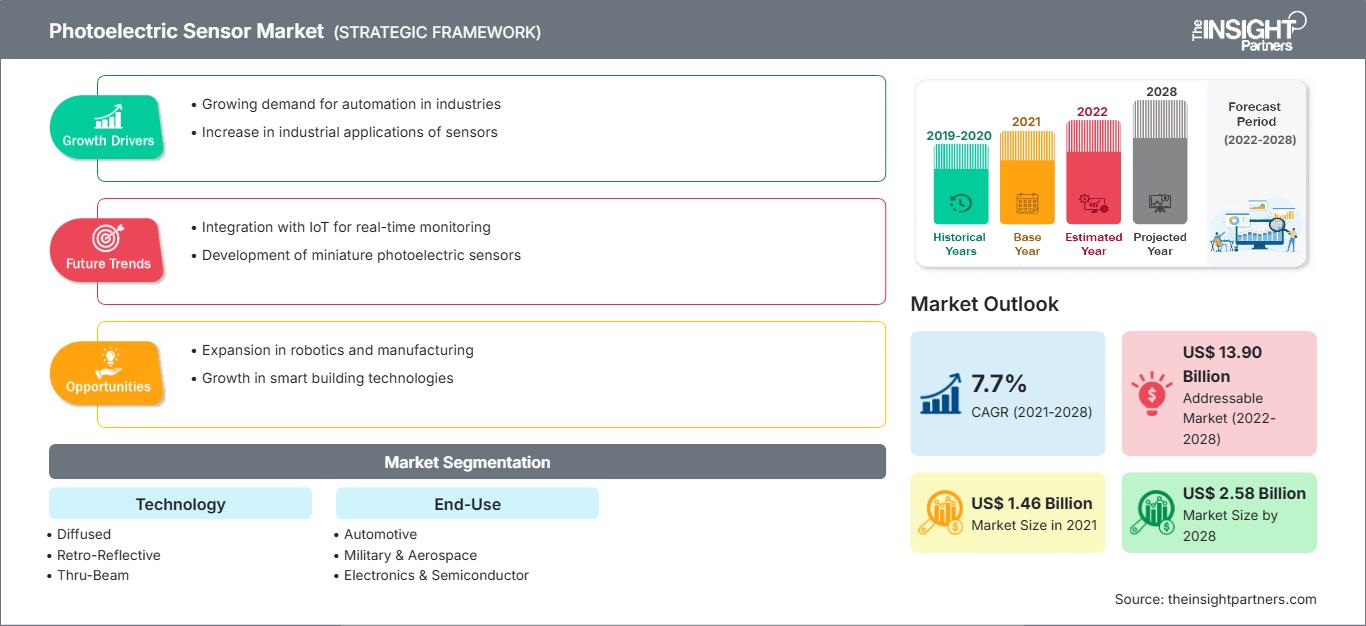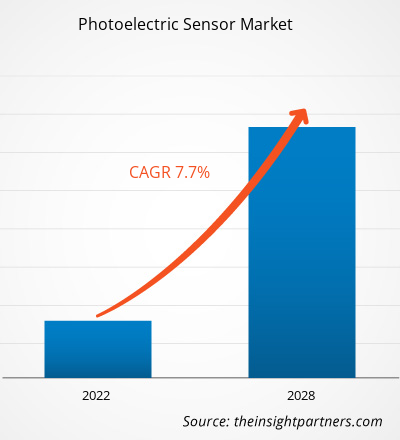[Informe de investigación] El mercado de sensores fotoeléctricos se valoró en 1.458,23 millones de dólares estadounidenses en 2021 y se prevé que alcance los 2.577,56 millones de dólares estadounidenses en 2028; se espera que crezca a una tasa de crecimiento anual compuesta (TCAC) del 7,7% entre 2021 y 2028.
Los sensores fotoeléctricos están ganando popularidad debido a su alta fiabilidad y capacidad de detección de objetos a larga distancia, independientemente del tamaño, la forma, el color, el material y las propiedades de la superficie de los objetos. Estos sensores están diseñados para operar en condiciones adversas; además, incorporan tecnologías avanzadas que garantizan la supresión eficaz de reflejos no deseados. Estas capacidades los hacen más versátiles que muchos otros tipos de sensores e idóneos para uso industrial. Por ejemplo, los sensores retrorreflectivos con filtros de polarización detectan la posición de un vagón de cualquier forma y material, que debe mantenerse dentro o fuera de la vía de una montaña rusa. Asimismo, los sensores fotoeléctricos se utilizan ampliamente en las industrias militar y aeroespacial debido a su alta precisión y rendimiento fiable. Se emplean en aviones de carga para la detección de humo e incendios. Además, los sensores fotoeléctricos ayudan a los fabricantes de fuselajes y motores a monitorizar parámetros de sistemas aeroespaciales como la presión, la temperatura, la aceleración, la posición óptica y la velocidad. Además, la industria de defensa utiliza ampliamente equipos de detección biológica para detectar la presencia de sustancias químicas en el medio ambiente y evaluar el riesgo de posibles amenazas biológicas mediante la detección de materiales biológicos nocivos, con el fin de proteger tanto a la población militar como a la civil. Por lo tanto, la precisión y la fiabilidad del funcionamiento de los sensores fotoeléctricos los convierten en el tipo de sensor preferido en condiciones industriales adversas.
Impacto de la pandemia de COVID-19 en el mercado de sensores fotoeléctricos
Según el último informe de la Organización Mundial de la Salud (OMS), Estados Unidos, España, Italia, Francia, Alemania, Reino Unido, Rusia, Turquía, Brasil, Irán y China se encuentran entre los países más afectados por el brote de COVID-19. En 2020, la economía mundial sufrió consecuencias significativas, y se prevé que los efectos perduren en cierta medida durante los próximos años. El brote interrumpió sectores clave como la electrónica, los semiconductores y la manufactura. La fuerte caída en el crecimiento de estos sectores está limitando el crecimiento del mercado de sensores fotoeléctricos. El cierre de fábricas, las prohibiciones de viajes y comercio, y el cierre de fronteras para combatir y contener la infección han impactado negativamente la fabricación, el suministro y las ventas de diversos productos de sensores.
Obtendrá personalización gratuita de cualquier informe, incluyendo partes de este informe, análisis a nivel de país y paquetes de datos de Excel. Además, podrá aprovechar excelentes ofertas y descuentos para empresas emergentes y universidades.
Mercado de sensores fotoeléctricos: Perspectivas estratégicas

- Obtenga las principales tendencias clave del mercado que se describen en este informe.Esta muestra GRATUITA incluirá análisis de datos, que abarcarán desde tendencias de mercado hasta estimaciones y pronósticos.
Los fabricantes de sensores fotoeléctricos se centran en reducir los costes operativos para mantener su competitividad. Sin embargo, se prevé que reanuden la producción tras el confinamiento. Se espera que las iniciativas gubernamentales para impulsar la economía y la flexibilización de las medidas de confinamiento fomenten la demanda de sensores fotoeléctricos durante el periodo de previsión. Es probable que la demanda de estos sensores aumente a medida que las nuevas tecnologías se adopten de forma más generalizada en las industrias automotriz y aeroespacial.
Perspectivas del mercado de sensores fotoeléctricos
El aumento de la demanda de sensores fotoeléctricos en la industria farmacéutica impulsa el crecimiento del mercado de sensores fotoeléctricos.
Las empresas farmacéuticas se centran en mejorar sus operaciones de fabricación evitando discrepancias como el envasado vacío, que puede deberse a la falta de comprimidos en la línea de producción. El sector está implementando cada vez más sensores fotoeléctricos para el recuento de comprimidos, el llenado de frascos y la verificación del recuento (en ensayos clínicos). Estos sensores también se utilizan en máquinas automatizadas de dispensación de recetas en farmacias y hospitales. Además, los avances en los sensores fotoeléctricos en cuanto a su rango de detección, que mejora su precisión de recuento, junto con el mantenimiento de entornos de producción higiénicos al evitar el contacto humano durante el envasado de medicamentos, son ventajas asociadas a estos sensores. Asimismo, el sensor fotoeléctrico proporciona una solución rentable, que se consigue mediante la automatización de la línea de producción en la industria farmacéutica. Por lo tanto,
El auge en la adopción de sensores fotoeléctricos en las empresas farmacéuticas se debe principalmente a su capacidad para aumentar la eficiencia, reducir los costos operativos y facilitar la monitorización de la producción en tiempo real. Estos sensores automatizan la medición de los niveles superior e inferior de líquidos en recipientes o tanques. El uso de productos químicos altamente corrosivos (ácidos o básicos) es habitual en las empresas farmacéuticas, por lo que la detección de los niveles de líquidos en los tanques de almacenamiento es una tarea fundamental en estas plantas. Por lo tanto, el creciente uso de sensores fotoeléctricos en la industria farmacéutica impulsará el crecimiento del mercado de sensores fotoeléctricos en los próximos años.
Perspectivas de mercado basadas en la tecnología
Según su tecnología, el mercado de sensores fotoeléctricos se segmenta en difusos, retrorreflectivos y de haz directo. En 2020, el segmento retrorreflectivo representó la mayor cuota de mercado.
Información de mercado basada en el usuario final
Según el usuario final, el mercado de sensores fotoeléctricos se segmenta en automoción, sector militar y aeroespacial, electrónica y semiconductores, embalaje y otros. En 2020, el segmento de automoción representó la mayor cuota de mercado.
Las empresas que operan en el mercado de sensores fotoeléctricos adoptan estrategias como fusiones, adquisiciones e iniciativas de mercado para mantener su posición. A continuación, se enumeran algunos avances de los principales actores:
- En abril de 2020, Balluff Photoelectric Sensors proporcionó datos de monitorización de estado. El portafolio de sistemas inteligentes de automatización y monitorización (SAMS) incluye sensores fotoeléctricos de alta precisión, monitorización de estado y tecnologías avanzadas de enlace de E/S, todas ellas diseñadas para minimizar el tiempo de inactividad al facilitar la resolución de problemas, los cambios de formato y la configuración de la maquinaria.
- En febrero de 2020, Eaton Corp plc fue incluida en la lista de las empresas más admiradas del mundo en 2020 por la revista Fortune.
Perspectivas regionales del mercado de sensores fotoeléctricos
Los analistas de The Insight Partners han explicado en detalle las tendencias y los factores regionales que influyen en el mercado de sensores fotoeléctricos durante el período de previsión. Esta sección también analiza los segmentos y la geografía del mercado de sensores fotoeléctricos en Norteamérica, Europa, Asia Pacífico, Oriente Medio y África, y Sudamérica y Centroamérica.
Alcance del informe de mercado de sensores fotoeléctricos
| Atributo del informe | Detalles |
|---|---|
| Tamaño del mercado en 2021 | 1.460 millones de dólares estadounidenses |
| Tamaño del mercado para 2028 | 2.580 millones de dólares estadounidenses |
| Tasa de crecimiento anual compuesto global (2021 - 2028) | 7,7% |
| Datos históricos | 2019-2020 |
| período de previsión | 2022-2028 |
| Segmentos cubiertos | Por la tecnología
|
| Regiones y países cubiertos | América del norte
|
| Líderes del mercado y perfiles de empresas clave |
|
Densidad de los participantes en el mercado de sensores fotoeléctricos: comprensión de su impacto en la dinámica empresarial
El mercado de sensores fotoeléctricos está creciendo rápidamente, impulsado por la creciente demanda de los usuarios finales debido a factores como la evolución de las preferencias de los consumidores, los avances tecnológicos y una mayor conciencia de los beneficios del producto. A medida que aumenta la demanda, las empresas amplían su oferta, innovan para satisfacer las necesidades de los consumidores y aprovechan las nuevas tendencias, lo que impulsa aún más el crecimiento del mercado.

- Obtenga una visión general de los principales actores del mercado de sensores fotoeléctricos.
El mercado global de sensores fotoeléctricos se ha segmentado como se indica a continuación:
Por la tecnología
- Difundido
- Retrorreflectante
- Haz pasante
Por el usuario final
- Automotor
- Militar y aeroespacial
- Electrónica y semiconductores
- Embalaje
- Otros
Por geografía
- América del norte
- A NOSOTROS
- Canadá
- México
- Europa
- Francia
- Alemania
- Italia
- Reino Unido
- Rusia
- El resto de Europa
- Asia Pacífico (APAC)
- Porcelana
- India
- Corea del Sur
- Japón
- Australia
- Resto de Asia Pacífico
- Oriente Medio y África (MEA)
- Sudáfrica
- Arabia Saudita
- Emiratos Árabes Unidos
- Resto de Oriente Medio y África
- Sudamérica (SAM)
- Brasil
- Argentina
- El resto de SAM
Perfiles de empresas
- Corporación Autonics
- Balluff GmbH
- Eaton Corporation plc
- Ifm Electronic GmbH
- Corporación Keyence
- Corporación OMRON
- Rockwell Automation, Inc.
- Corporación Panasonic
- SICK AG
- Schneider Electric SE
- Análisis histórico (2 años), año base, pronóstico (7 años) con CAGR
- Análisis PEST y FODA
- Tamaño del mercado, valor/volumen: global, regional y nacional
- Industria y panorama competitivo
- Conjunto de datos de Excel
Informes recientes
Informes relacionados
Testimonios
Razón para comprar
- Toma de decisiones informada
- Comprensión de la dinámica del mercado
- Análisis competitivo
- Información sobre clientes
- Pronósticos del mercado
- Mitigación de riesgos
- Planificación estratégica
- Justificación de la inversión
- Identificación de mercados emergentes
- Mejora de las estrategias de marketing
- Impulso de la eficiencia operativa
- Alineación con las tendencias regulatorias






















 Obtenga una muestra gratuita para - Mercado de sensores fotoeléctricos
Obtenga una muestra gratuita para - Mercado de sensores fotoeléctricos